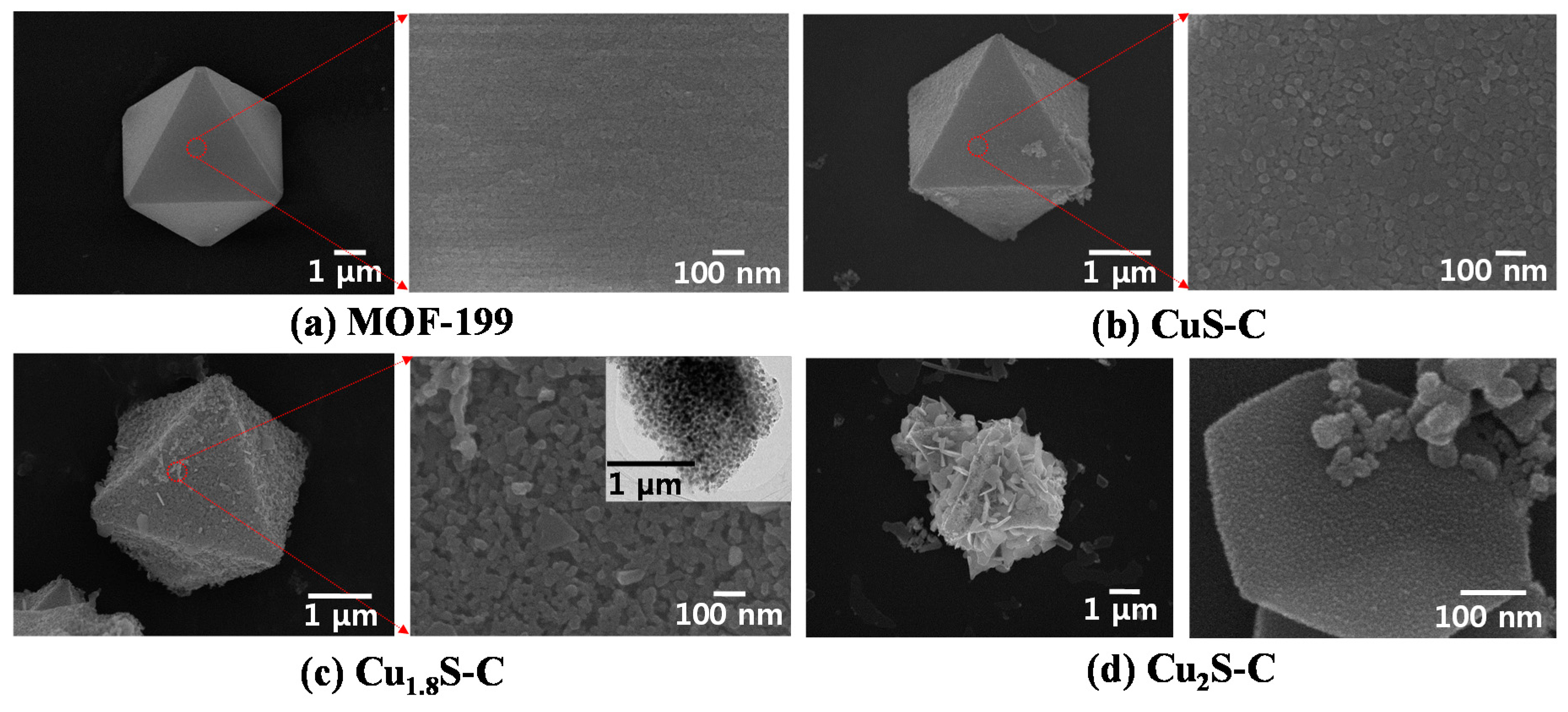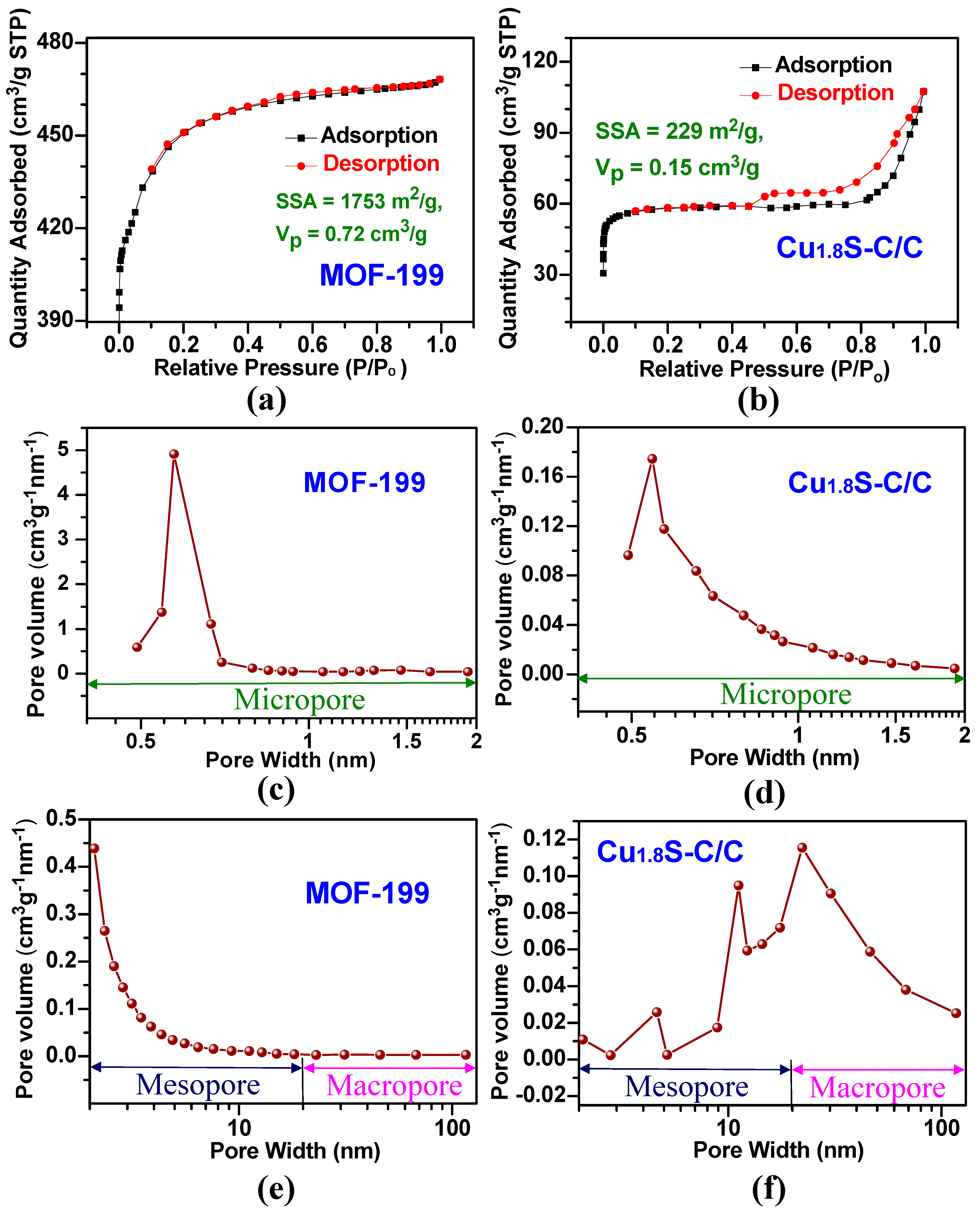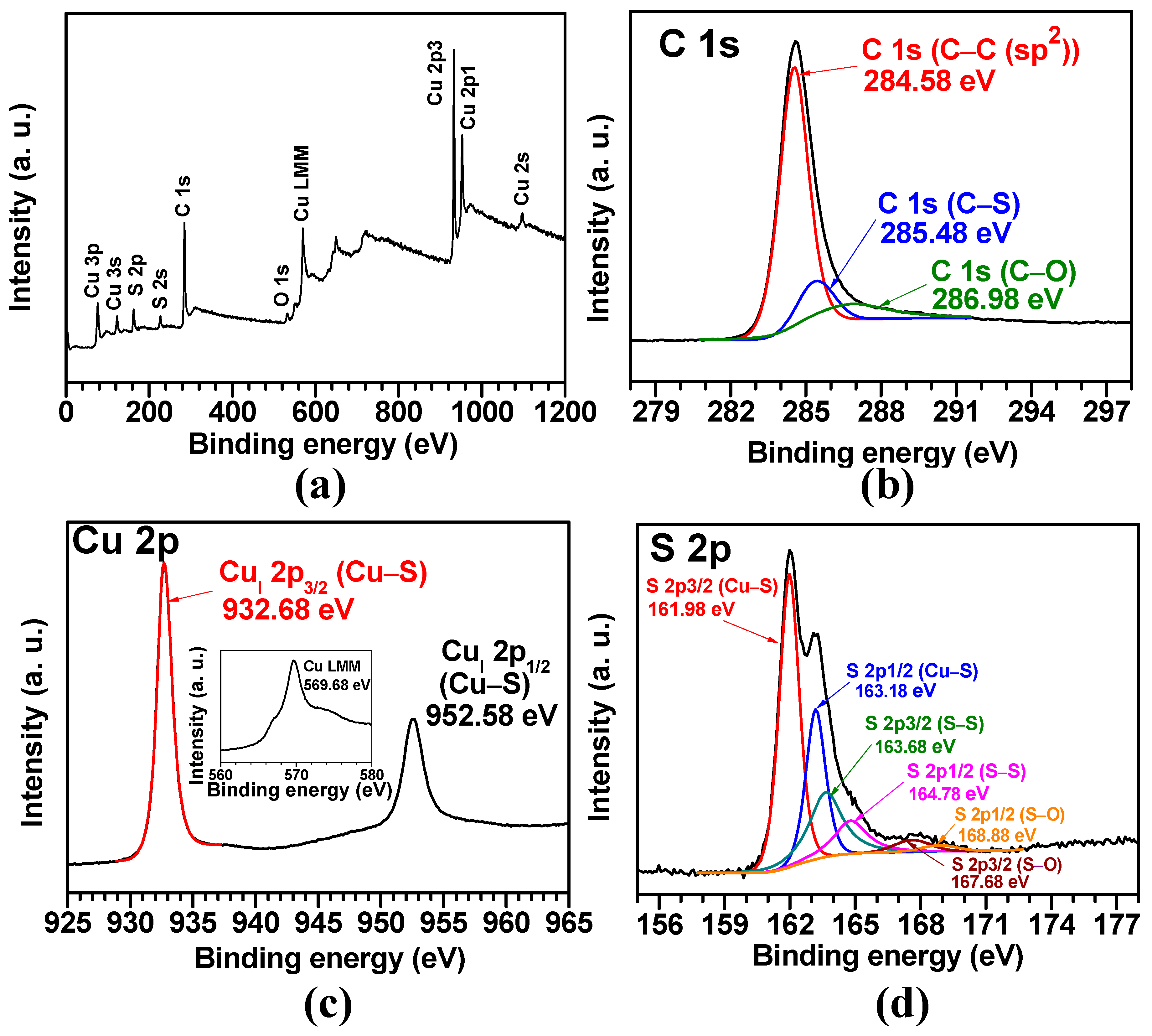Highly Efficient Nanocarbon Coating Layer on the Nanostructured Copper Sulfide-Metal Organic Framework Derived Carbon for Advanced Sodium-Ion Battery Anode
Abstract
:1. Introduction
2. Materials and Methods
2.1. Synthesis of MOF-199
2.2. Synthesis of CuxS-MOF-Derived Carbon
2.3. Synthesis of Cu1.8S-MOF-Derived Carbon/Carbon Core/Shell Structure
2.4. Structural Analysis of CuxS-C/C
2.5. Sodium Ion Battery Performance of CuxS-C and Cu1.8S-C/C Anode Structures
3. Results and Discussion
3.1. Structural and Morphological Properties of MOF-199, CuxS-C and Cu1.8S-C/C Core/Shell Structures
3.2. Thermogravimetric Analysis of MOF-199 and CuxS-C Structures
3.3. Structural and Morphological Properties of Cu1.8S-C/C Core/Shell Structures
3.4. Surface Area and Porosity of MOF-199 and Cu1.8S-C/C Core/Shell Structures
3.5. X-ray Photoelectron Spectroscopy Analysis of Cu1.8S-C/C Core/Shell Structure
3.6. Electrochemical Performance of CuxS-C and Cu1.8S-C/C Core/Shell Structures
4. Conclusions
Supplementary Materials
Author Contributions
Funding
Acknowledgments
Conflicts of Interest
References
- Vaalma, C.; Buchholz, D.; Weil, M.; Passerini, S. A cost and resource analysis of sodium-ion batteries. Nat. Rev. Mater. 2018, 3, 18013. [Google Scholar] [CrossRef]
- Jian, Z.; Xing, Z.; Bommier, C.; Li, Z.; Ji, X. Hard carbon microspheres: Potassium-ion anode versus sodium-ion anode. Adv. Energy Mater. 2016, 6, 1501874. [Google Scholar] [CrossRef]
- Park, H.; Kwon, J.; Choi, H.; Shin, D.; Song, T.; Lou, X.W.D. Unusual Na+ ion intercalation/deintercalation in metal-rich Cu1.8S for Na-ion batteries. ACS Nano 2018, 12, 2827–2837. [Google Scholar] [CrossRef] [PubMed]
- Banerjee, A.; Singh, U.; Aravindan, V.; Srinivasan, M.; Ogale, S. Synthesis of CuO nanostructures from Cu-based metal organic framework (MOF-199) for application as anode for Li-ion batteries. Nano Energy 2013, 2, 1158–1163. [Google Scholar] [CrossRef]
- Qi, F.; He, J.; Chen, Y.; Zheng, B.; Li, Q.; Wang, X.; Yu, B.; Lin, J.; Zhou, J.; Li, P. Few-layered ReS2 nanosheets grown on carbon nanotubes: A highly efficient anode for high-performance lithium-ion batteries. Chem. Eng. J. 2017, 315, 10–17. [Google Scholar] [CrossRef]
- Hwang, J.-Y.; Myung, S.-T.; Sun, Y.-K. Sodium-ion batteries: Present and future. Chem. Soc. Rev. 2017, 46, 3529–3614. [Google Scholar] [CrossRef]
- Xiao, Y.; Su, D.; Wang, X.; Wu, S.; Zhou, L.; Shi, Y.; Fang, S.; Cheng, H.M.; Li, F. CuS Microspheres with Tunable Interlayer Space and Micropore as a High-Rate and Long-Life Anode for Sodium-Ion Batteries. Adv. Energy Mater. 2018, 8, 1800930. [Google Scholar] [CrossRef]
- Han, F.; Li, W.C.; Li, D.; Lu, A.H. In situ electrochemical generation of mesostructured Cu2S/C composite for enhanced lithium storage: Mechanism and material properties. ChemElectroChem 2014, 1, 733–740. [Google Scholar] [CrossRef]
- Ren, Y.; Wei, H.; Yang, B.; Wang, J.; Ding, J. “Double-Sandwich-Like” CuS@ reduced graphene oxide as an anode in lithium ion batteries with enhanced electrochemical performance. Electrochim. Acta 2014, 145, 193–200. [Google Scholar] [CrossRef]
- Ding, X.; Lei, S.; Du, C.; Xie, Z.; Li, J.; Huang, X. Small-Sized CuS Nanoparticles/N, S Co-Doped rGO Composites as the Anode Materials for High-Performance Lithium-Ion Batteries. Adv. Mater. Interfaces 2019, 6, 1900038. [Google Scholar] [CrossRef]
- Feng, C.; Zhang, L.; Yang, M.; Song, X.; Zhao, H.; Jia, Z.; Sun, K.; Liu, G. One-pot synthesis of copper sulfide nanowires/reduced graphene oxide nanocomposites with excellent lithium-storage properties as anode materials for lithium-ion batteries. ACS Appl. Mater. Interfaces 2015, 7, 15726–15734. [Google Scholar] [CrossRef] [PubMed]
- Cai, R.; Chen, J.; Zhu, J.; Xu, C.; Zhang, W.; Zhang, C.; Shi, W.; Tan, H.; Yang, D.; Hng, H.H. Synthesis of Cu x S/Cu nanotubes and their lithium storage properties. J. Phys. Chem. C 2012, 116, 12468–12474. [Google Scholar] [CrossRef]
- Wang, Z.; Zhang, X.; Zhang, Y.; Li, M.; Qin, C.; Bakenov, Z. Chemical Dealloying Synthesis of CuS Nanowire-on-Nanoplate Network as Anode Materials for Li-Ion Batteries. Metals 2018, 8, 252. [Google Scholar] [CrossRef]
- Foley, S.; Geaney, H.; Bree, G.; Stokes, K.; Connolly, S.; Zaworotko, M.J.; Ryan, K.M. Copper Sulfide (CuxS) Nanowire-in-Carbon Composites Formed from Direct Sulfurization of the Metal-Organic Framework HKUST-1 and Their Use as Li-Ion Battery Cathodes. Adv. Funct. Mater. 2018, 28, 1800587. [Google Scholar] [CrossRef]
- Zhou, M.; Peng, N.; Liu, Z.; Xi, Y.; He, H.; Xia, Y.; Liu, Z.; Okada, S. Synthesis of sub-10ánm copper sulphide rods as high-performance anode for long-cycle life Li-ion batteries. J. Power Sources 2016, 306, 408–412. [Google Scholar] [CrossRef]
- Kalimuldina, G.; Taniguchi, I. Electrochemical properties of stoichiometric CuS coated on carbon fiber paper and Cu foil current collectors as cathode material for lithium batteries. J. Mater. Chem. A 2017, 5, 6937–6946. [Google Scholar] [CrossRef]
- McDowell, M.T.; Lu, Z.; Koski, K.J.; Yu, J.H.; Zheng, G.; Cui, Y. In situ observation of divergent phase transformations in individual sulfide nanocrystals. Nano Lett. 2015, 15, 1264–1271. [Google Scholar] [CrossRef]
- An, C.; Ni, Y.; Wang, Z.; Li, X.; Liu, X. Facile fabrication of CuS microflower as a highly durable sodium-ion battery anode. Inorg. Chem. Front. 2018, 5, 1045–1052. [Google Scholar] [CrossRef]
- Kim, J.-S.; Kim, D.-Y.; Cho, G.-B.; Nam, T.-H.; Kim, K.-W.; Ryu, H.-S.; Ahn, J.-H.; Ahn, H.-J. The electrochemical properties of copper sulfide as cathode material for rechargeable sodium cell at room temperature. J. Power Sources 2009, 189, 864–868. [Google Scholar] [CrossRef]
- Wang, Y.; Li, H.; Zhang, Y.; Peng, Y.; Zhang, P.; Zhao, J. Self-templating thermolysis synthesis of Cu 2–x S@ M (M= C, TiO 2, MoS 2) hollow spheres and their application in rechargeable lithium batteries. Nano Res. 2018, 11, 831–844. [Google Scholar] [CrossRef]
- Meng, X.; Riha, S.C.; Libera, J.A.; Wu, Q.; Wang, H.-H.; Martinson, A.B.; Elam, J.W. Tunable core-shell single-walled carbon nanotube-Cu2S networked nanocomposites as high-performance cathodes for lithium-ion batteries. J. Power Sources 2015, 280, 621–629. [Google Scholar] [CrossRef] [Green Version]
- Li, J.; Yan, D.; Lu, T.; Qin, W.; Yao, Y.; Pan, L. Significantly improved sodium-ion storage performance of CuS nanosheets anchored into reduced graphene oxide with ether-based electrolyte. ACS Appl. Mater. Interfaces 2017, 9, 2309–2316. [Google Scholar] [CrossRef] [PubMed]
- Jache, B.; Mogwitz, B.; Klein, F.; Adelhelm, P. Copper sulfides for rechargeable lithium batteries: Linking cycling stability to electrolyte composition. J. Power Sources 2014, 247, 703–711. [Google Scholar] [CrossRef]
- Xia, W.; Mahmood, A.; Zou, R.; Xu, Q. Metal–organic frameworks and their derived nanostructures for electrochemical energy storage and conversion. Energy Environ. Sci. 2015, 8, 1837–1866. [Google Scholar] [CrossRef]
- Ethiraj, J.; Bonino, F.; Lamberti, C.; Bordiga, S. H2S interaction with HKUST-1 and ZIF-8 MOFs: A multitechnique study. Microporous Mesoporous Mater. 2015, 207, 90–94. [Google Scholar] [CrossRef]
- Petit, C.; Bandosz, T.J. Exploring the coordination chemistry of MOF–graphite oxide composites and their applications as adsorbents. Dalton Trans. 2012, 41, 4027–4035. [Google Scholar] [CrossRef] [PubMed]
- Yoon, M.; Srirambalaji, R.; Kim, K. Homochiral metal–organic frameworks for asymmetric heterogeneous catalysis. Chem. Rev. 2011, 112, 1196–1231. [Google Scholar] [CrossRef]
- Ren, W.; Zhang, H.; Guan, C.; Cheng, C. Ultrathin MoS2 Nanosheets@ Metal Organic Framework-Derived N-Doped Carbon Nanowall Arrays as Sodium Ion Battery Anode with Superior Cycling Life and Rate Capability. Adv. Funct. Mater. 2017, 27, 1702116. [Google Scholar] [CrossRef]
- Wang, L.; Han, Y.; Feng, X.; Zhou, J.; Qi, P.; Wang, B. Metal–organic frameworks for energy storage: Batteries and supercapacitors. Coord. Chem. Rev. 2016, 307, 361–381. [Google Scholar] [CrossRef]
- Zhang, Z.; An, Y.; Feng, J.; Ci, L.; Duan, B.; Huang, W.; Dong, C.; Xiong, S. Carbon coated copper sulfides nanosheets synthesized via directly sulfurizing Metal-Organic Frameworks for lithium batteries. Mater. Lett. 2016, 181, 340–344. [Google Scholar] [CrossRef]
- Chui, S.S.-Y.; Lo, S.M.-F.; Charmant, J.P.; Orpen, A.G.; Williams, I.D. A chemically functionalizable nanoporous material [Cu3(TMA)2(H2O)3]n. Science 1999, 283, 1148–1150. [Google Scholar] [CrossRef] [PubMed]
- Ahn, C.; Lee, J.; Kim, H.U.; Bark, H.; Jeon, M.; Ryu, G.H.; Lee, Z.; Yeom, G.Y.; Kim, K.; Jung, J. Low-temperature synthesis of large-scale molybdenum disulfide thin films directly on a plastic substrate using plasma-enhanced chemical vapor deposition. Adv. Mater. 2015, 27, 5223–5229. [Google Scholar] [CrossRef] [PubMed]
- Wu, R.; Wang, D.P.; Kumar, V.; Zhou, K.; Law, A.W.; Lee, P.S.; Lou, J.; Chen, Z. MOFs-derived copper sulfides embedded within porous carbon octahedra for electrochemical capacitor applications. Chem. Commun. 2015, 51, 3109–3112. [Google Scholar] [CrossRef] [PubMed]
- Kang, C.; Patel, M.; Rangasamy, B.; Jung, K.-N.; Xia, C.; Shi, S.; Choi, W. Three-dimensional carbon nanotubes for high capacity lithium-ion batteries. J. Power Sources 2015, 299, 465–471. [Google Scholar] [CrossRef]
- Liu, B.; Li, Y.; Oh, S.C.; Fang, Y.; Xi, H. Fabrication of a hierarchically structured HKUST-1 by a mixed-ligand approach. RSC Adv. 2016, 6, 61006–61012. [Google Scholar] [CrossRef]
- Kruk, M.; Jaroniec, M. Gas adsorption characterization of ordered organic− inorganic nanocomposite materials. Chem. Mater. 2001, 13, 3169–3183. [Google Scholar] [CrossRef]
- Mezgebe, M.M.; Ju, A.; Wei, G.; Macharia, D.K.; Guang, S.; Xu, H. Structure based optical properties and catalytic activities of hydrothermally prepared CuS nanostructures. Nanotechnology 2019, 30, 105704. [Google Scholar] [CrossRef] [PubMed]
- Kumar, D.R.; Kesavan, S.; Baynosa, M.L.; Shim, J.-J. Flower-like Cu1. 8S nanostructures for high-performance flexible solid-state supercapacitors. Appl. Surf. Sci. 2018, 448, 547–558. [Google Scholar] [CrossRef]
- Navarro-Pardo, F.; Jin, L.; Adhikari, R.; Tong, X.; Benetti, D.; Basu, K.; Vanka, S.; Zhao, H.; Mi, Z.; Sun, S. Nanofiber-supported CuS nanoplatelets as high efficiency counter electrodes for quantum dot-based photoelectrochemical hydrogen production. Mater. Chem. Front. 2017, 1, 65–72. [Google Scholar] [CrossRef]
- Galtayries, A.; Grimblot, J.; Bonnelle, J.P. Interaction of SO2 with different polycrystalline Cu, Cu2O and CuO surfaces. Surf. Interface Anal. 1996, 24, 345–354. [Google Scholar] [CrossRef]








© 2019 by the authors. Licensee MDPI, Basel, Switzerland. This article is an open access article distributed under the terms and conditions of the Creative Commons Attribution (CC BY) license (http://creativecommons.org/licenses/by/4.0/).
Share and Cite
Kang, C.; Lee, Y.; Kim, I.; Hyun, S.; Lee, T.H.; Yun, S.; Yoon, W.-S.; Moon, Y.; Lee, J.; Kim, S.; et al. Highly Efficient Nanocarbon Coating Layer on the Nanostructured Copper Sulfide-Metal Organic Framework Derived Carbon for Advanced Sodium-Ion Battery Anode. Materials 2019, 12, 1324. https://doi.org/10.3390/ma12081324
Kang C, Lee Y, Kim I, Hyun S, Lee TH, Yun S, Yoon W-S, Moon Y, Lee J, Kim S, et al. Highly Efficient Nanocarbon Coating Layer on the Nanostructured Copper Sulfide-Metal Organic Framework Derived Carbon for Advanced Sodium-Ion Battery Anode. Materials. 2019; 12(8):1324. https://doi.org/10.3390/ma12081324
Chicago/Turabian StyleKang, Chiwon, Yongwoo Lee, Ilhwan Kim, Seungmin Hyun, Tae Hoon Lee, Soyeong Yun, Won-Sub Yoon, Youngkwang Moon, Jinkee Lee, Sunkook Kim, and et al. 2019. "Highly Efficient Nanocarbon Coating Layer on the Nanostructured Copper Sulfide-Metal Organic Framework Derived Carbon for Advanced Sodium-Ion Battery Anode" Materials 12, no. 8: 1324. https://doi.org/10.3390/ma12081324





